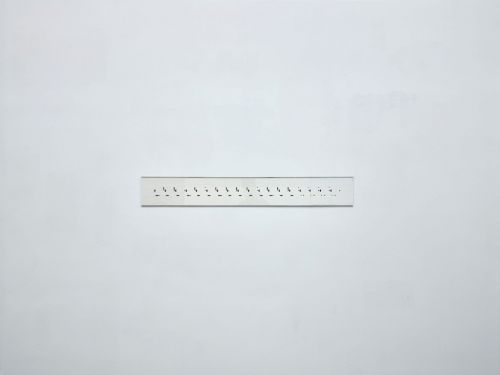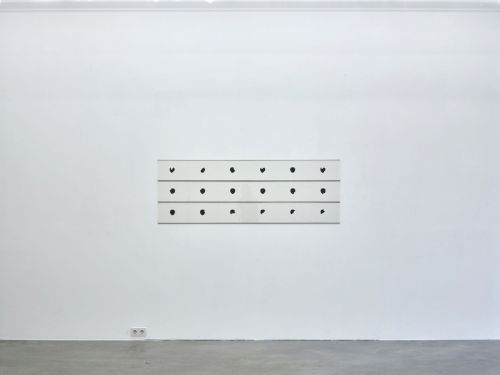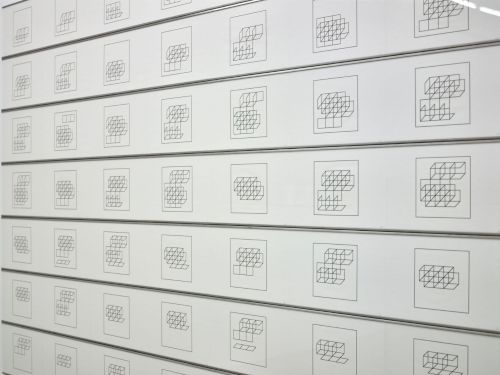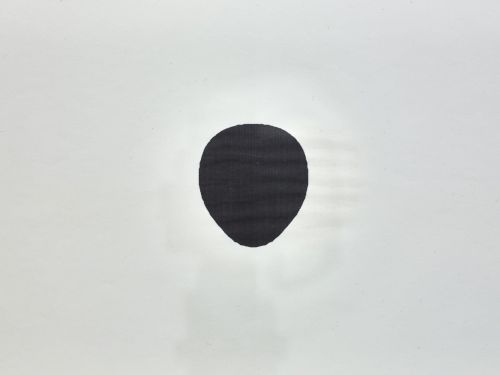Machines to change the world
Elena Asins
Opening › Feb 14, 6:00 PM
Feb 15 – Mar 14, 2020
Algorithms create a steadily growing part of our world. But we actually don't visually grasp them. The pure mathematics that take place behind the appearances of the digital age remain invisible to most people. The formal computing processes in the server halls of social media corporations and cloud service providers, the performance of the software on billions of computers, they have hardly any visual form outside the institutes and sweatshops for IT. The pure mathematics behind the operating systems of 21st century societies has no representation, no public aesthetics.
Algorithmen erzeugen einen stetig wachsenden Teil der Welt, die wir sehen. Aber sie selbst sehen wir nicht. Die reine Mathematik, die sich hinter den Erscheinungen des digitalen Zeitalters abspielt, bleibt für die meisten Menschen unsichtbar. Die formalen Rechenprozesse in den Serverhallen der Social Media Konzerne und der Clouddienste, die Performance der Software auf Milliarden von Computern, sie haben außerhalb der Institute und Sweatshops für Informatik kaum eine visuelle Gestalt. Die reine Mathematik hinter den Betriebssystemen der Gesellschaften des 21. Jahrhunderts hat keine Repräsentation, keine öffentliche Ästhetik.
Well, no representation is slightly exaggerated. If you google it, there are all sorts of charts and diagrams, and art has also found forms to make the invisible logic of the computer age visible here and there. One of the pioneers of this art was the Spaniard Elena Asins, who died in 2015. Following the constructivist traditions of the avant-garde movement of the 20th century, the artist, writer, lecturer and critic brought together minimalist and geometric tendencies from the 1960s with the theoretical computer science and semiotics of Noam Chomsky from 1963 onwards.
Sounds complicated? The result is not. We show some of Elena Asins rare works from the 1980s. The computer needle prints on thin continuous paper appear like metamorphoses of a concrete poetry of the digital era, like meditations on the logical constants that lie behind the continuous change that is taking place before our eyes. “I am interested in having the nature of the structure, the basis of all possible constructions in my hand. The organization of elements that create a world; it creates an aesthetic. It is a game in the Wittgensteinian sense that reveals the truth or the logic of things. ”
Elena Asins' artistic research was closely linked to the experimental circles that emerged in Spain in the past decades of the Franco dictatorship. These groups included the Cooperativa de Producción Artística y Artesana (Cooperative for Arts and Crafts), in which the visual arts were united with poetry, linguistics, music and architecture. Another important group was formed in 1966 at the computer center at the Universidad Autónoma de Madrid, where Asins worked. Further research led her to the University of Stuttgart, Columbia University and the New School for Social Research in New York. Today the Museo Nacional Centro de Arte Reina Sofía manages the estate and her artistic legacy.
The exhibition was created in cooperation with the Europäischer Kunstverein.
text: Alexander Koch
photography: Ladislav Zajac
Nun, keine ist übertrieben. Googelt man, finden sich allerhand Schaudiagramme und schematische Darstellungen, und auch die Kunst hat Formen gefunden, die unsichtbare Logik des Computerzeitalters hier und da sichtbar zu machen. Eine der Pionierinnen dieser Kunst war die 2015 verstorbene Spanierin Elena Asins. Im Anschluss an konstruktivistische Traditionen der Avantgardebewegung des 20. Jahrhunderts führte die Künstlerin, Schriftstellerin, Dozentin und Kritikerin in ihrer Arbeit ab 1963 minimalistische und geometrische Tendenzen der 1960er Jahre mit der theoretischen Informatik und der Semiotik Noam Chomskys zusammen.
Klingt kompliziert? Das Ergebnis ist es nicht. Wir zeigen einige des seltenen Arbeiten von Elena Asins aus den Achtzigerjahren. Die Computernadeldrucke auf dünnem Endlospapier erscheinen wie Metamorphosen einer konkreten Poesie der digitalen Ära, wie Meditationen über die logischen Konstanten, die hinter der kontinuierlichen Veränderung liegen, die sich vor unseren Augen abspielt. „Mich interessiert, das Wesen der Struktur, die Grundlage aller möglichen Konstruktionen in meiner Hand zu haben. Die Organisation von Elementen, die eine Welt erzeugen; sie erzeugt eine Ästhetik. Es ist ein Spiel im Wittgenstein'schen Sinne, das die Wahrheit oder die Logik der Dinge offenbart.“
Elena Asins künstlerische Forschung war eng mit den experimentellen Kreisen verbunden, die in Spanien in den letzten Jahrzehnten der Franko-Diktatur entstanden. Zu diesen Gruppen gehörte die Cooperativa de Producción Artística y Artesana (Genossenschaft für Kunst und Handwerk), in der die bildenden Künste eine Einheit mit Poesie, Linguistik, Musik und Architektur eingingen. Eine weitere wichtige Gruppe bildete sich ab 1966 am Computerzentrum an der Universidad Autónoma de Madrid, wo Asins arbeitete. Weitere Forschungen führten sie an die Universität Stuttgart, die Columbia University und die New School for Social Research in New York. Heute verwaltet das Museo Nacional Centro de Arte Reina Sofía ihren künstlerischen Nachlass.
Die Ausstellung wurde in Zusammenarbeit mit dem Europäischen Kunstverein realisiert.
text: Alexander Koch
photography: Ladislav Zajac







- Current
- Upcoming
- 2025
- 2024
- 2023
- 2022
- 2021
- 2020
- 2019
- 2018
- 2017
- 2016
- 2015
- 2014
- 2013
- 2012
- 2011
- 2010
- 2009